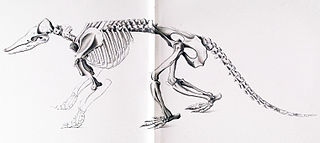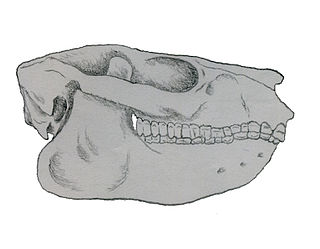Description
This animal is only known from isolated osteoderms, who were large and thick, quite similar to those of the later pampatheres. Some of these osteoderms, belonging to the fixed carapace typical of many cingulates, show the start of the differentiation of secondary figures, and large central follicles. The mobile osteoderms were distinguished from those of pampatheres by a little differentiated and rough surface. A bilobed tooth, similar to those of pampatheres, but whose abrasion surface draw a cusp in the anterior section, has also been attributed to the genus Machlydotherium.
Classification
The genus Machlydotherium was first described in 1902 by Florentino Ameghino, the name itself being an anagram of Chlamydotherium , another genus of cingulates. The type species, Machlydotherium asperum, dates from the Late Eocene, but osteoderms attributed to the genus have also been found in terrains dated from the Middle Eocene to the Early Oligocene. Ameghino described several species besides the type species, such as Machlydotherium ater, M. sparsum and M. intortum, the latter now erected as its own genus, Yuruatherium .
Due to the scarcity of its remains, its antiquity and the specificities of the shape of its osteoderms, Machlydotherium can hardly be placed in a specific clade of cingulate. It seems to have been close to the pampatheres, the oldest of which only dating back from the Middle Miocene. It is possible that Machlydotherium evolved independently from the pampatheres, becoming extinct without leaving known descendants during the Oligocene.

Cingulata, part of the superorder Xenarthra, is an order of armored New World placental mammals. Dasypodids and chlamyphorids, the armadillos, are the only surviving families in the order. Two groups of cingulates much larger than extant armadillos existed until recently: pampatheriids, which reached weights of up to 200 kg (440 lb) and chlamyphorid glyptodonts, which attained masses of 2,000 kg (4,400 lb) or more.

Stegotherium is an extinct genus of long-nosed armadillo, belonging to the Dasypodidae family alongside the nine-banded armadillo. It is currently the only genus recognized as a member of the tribe Stegotheriini. It lived during the Early Miocene of Patagonia and was found in Colhuehuapian rocks from the Sarmiento Formation, Santacrucian rocks from the Santa Cruz Formation, and potentially also in Colloncuran rocks from the Middle Miocene Collón Curá Formation. Its strange, almost toothless and elongated skull indicates a specialization for myrmecophagy, the eating of ants, unique among the order Cingulata, which includes pampatheres, glyptodonts and all the extant species of armadillos.
Ernestokokenia is an extinct genus of mammal, belonging to the Didolodontidae. It lived during the Early Eocene and the Middle Eocene, and its fossils were discovered in South America.

Anisolambda is an extinct genus of litoptern. It lived from the Late Paleocene to the Middle Eocene in what is now Argentina.
Henricosbornia is an extinct genus of henricosborniid notoungulate that lived from the Late Paleocene to the Middle Eocene of what is now Argentina and Brazil.
Eohyrax is an extinct genus of Notoungulate, belonging to the suborder Typotheria. It lived during the Middle Eocene, and its remains were discovered in South America.
Pseudhyrax is an extinct genus of archaeohyracid notoungulate. It lived from the Late Eocene to the Early Oligocene, of what is now South America.
Transpithecus is an extinct genus of Notoungulates, belonging to the suborder Typotheria. It lived during the Middle Eocene in what is today South America.

Isotemnus is an extinct genus of notoungulate belonging to the family Isotemnidae. It lived from the Late Paleocene to the Middle Eocene of what is now Argentina.

Periphragnis is an extinct genus of isotemnid notoungulates that lived from the Middle Eocene to the Early Oligocene in what is now Argentina and Chile.
Archaeopithecus is an extinct genus of Notoungulate, belonging to the suborder Typotheria. It lived during the Middle Eocene, in what is today Argentina.

Notopithecus is an extinct genus of Notoungulate, belonging to the suborder Typotheria. It lived from the Middle to the Late Eocene and its fossilized remains were discovered in South America.
Kraglievichia is an extinct genus of cingulate belonging to the family Pampatheriidae. It lived from the Late Miocene to the Early Pliocene, and its fossilized remains were discovered in South America.

Stenotatus is an extinct genus of cingulate, belonging to the family Dasypodidae. It lived from the Early to the Late Miocene in South America.
Astegotherium is an extinct genus of xenarthran, belonging to the family Dasypodidae. It lived from the Early to the Middle Eocene, and its fossilized remains are found in Argentina.

Prozaedyus is an extinct genus of chlamyphorid armadillo that lived during the Middle Oligocene and Middle Miocene in what is now South America.
Glyptatelus is an extinct genus of glyptodont. It lived from the Late Eocene to the Middle Oligocene in what is now Argentina and Bolivia.
Protoglyptodon is an extinct genus of Glyptodont. It lived during the Late Miocene, and its fossilized remains were found in South America.
Palaehoplophorus is an extinct genus of glyptodont. It lived from the Middle to the Late Miocene, and its fossilized remains were discovered in South America.
Vassallia is an extinct genus of cingulate belonging to the family Pampatheriidae. It lived between the Middle Oligocene and the Early Pliocene in what is now South America.
This page is based on this
Wikipedia article Text is available under the
CC BY-SA 4.0 license; additional terms may apply.
Images, videos and audio are available under their respective licenses.










